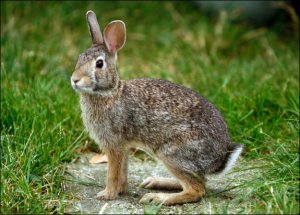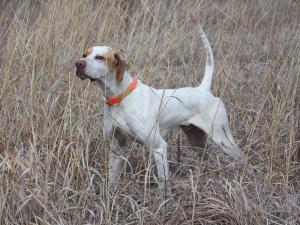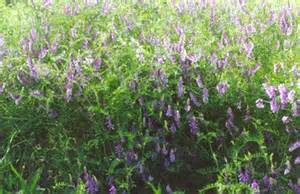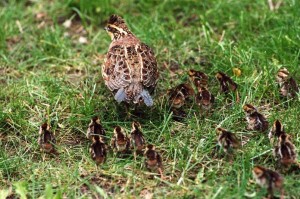Extension Forestry & Natural Resources
Wildlife & Fisheries Biology – Environmental & Natural Resources – Forest Resources
Cottontail Rabbit Biology and Management
Greg Yarrow, Professor of Wildlife Ecology, Extension Wildlife Specialist
Fact Sheet 8: Revised May 2009
The cottontail rabbit (Sylvilagus floridanus) is one game species familiar to virtually everyone. Its requirements for life are relatively simple and this, coupled with a high reproductive capacity, enables it to hold the title of the most important game animal in North America.
The cottontail was not abundant in the United States when the settlers arrived, but with the introduction of early agriculture, the cottontail increased. In recent years, changing land use practices, particularly conversion of patchy farming to forest production and intensive farming, have resulted in cottontail rabbit population declines. Declines will continue unless the habitat needs of cottontails are provided.
Three species of rabbits are found in South Carolina. The eastern cottontail is the most common and is statewide in distribution. The larger swamp rabbit or “cane cutter” occurs in the Piedmont, primarily along or adjacent to the Savannah River. The marsh rabbit inhabits the Coastal Plain portion of the state and is the smallest of the state’s rabbits.
Although these rabbits are three distinct species, they are all commonly referred to as cottontails by the average hunter and other laymen. Likewise, the terms cottontail and rabbit as used in this text will apply to the eastern cottontail and other rabbit species as well.
Life History
When the cold days of winter begin to merge with the warmer springlike days of late February and March, males or buck cottontails, seek does and mate, signifying the start of the breeding season which will run until late summer.
Near the end of the 28-day gestation period, the heavy-bodied female or doe will begin selecting a well-drained location, usually in an old field, open woodland, garden or even an open lawn, on which to construct her nest. There a nest cavity approximately five inches wide and seven inches long is constructed. After excavation is complete, the doe will line the nest cavity with layers of grass, leaves, or small roots which will later be topped with fur pulled from her underside.
At birth, baby cottontails weigh approximately one ounce, are blind, deaf and completely helpless. A litter of cottontails may vary in number from one to seven, but the average litter size is around three or four. The young remain hidden in the nest covered with dead litter or leaves and within 14 days are strong enough to leave their mother and the nest to fend for themselves. The doe cottontail may breed the same day the litter is born and may repeat the young rearing process three or four times during the breeding season. A new nest is generally constructed for each successive litter.
Foods and Cover Requirements
South Carolina cottontails eat an extremely wide variety of plant foods. Some of the more general items include grasses, sedges, sprouts, leaves, fruits, buds and bark. During the summer, cottontails dine primarily on grasses, legumes, succulent annuals, weeds, and an occasional garden vegetable. The winter diet includes small grains, as well as twigs, bark and buds of shrubs and trees. In agricultural areas, grains wasted in the field, such as corn and soybeans, provide a source of high energy food.
Cover requirements for cottontails closely resemble those of quail in that they require an interspersion of woodlands, brush, grass and cultivated lands — a diversity of habitat. Rabbits are fair game for nearly all predators, and for this reason suitable escape cover is crucial.
Habitat Improvements and Other Considerations
The cottontail is the number one game animal in the United States, although it may not rank as high in South Carolina as in other parts of the country. In general, rabbit hunting appears to be most popular in the Piedmont, possibly because of it’s relative abundance.
Rabbits actually require little management, but in no instance can there be more cottontails than a given piece of land can support. “Carrying capacity” is a term used to define the ability of an area to support wildlife, in this instance rabbits. Factors influencing the carrying capacity include the quality and quantity of food, cover, water supply, and other environmental or biotic factors which tend to limit the number of rabbits an area will support.
Limiting Factors
Rabbits are the most heavily preyed upon of all game species, and they are also susceptible to a variety of diseases and parasites, some of which can be deadly. During certain seasons of the year, some South Carolina predators, both terrestrial and avian, subsist mainly on a diet of cottontails. Due to their abundance, foxes are probably the most important predators on rabbits which at times compose as much as 50 percent of their diet. The bobcat is the perfectionist when it comes to catching rabbits and nearly 75 percent of its diet may be cottontails. Larger hawks and owls also consume rabbits readily and up to 40 percent of a great horned owl’s diet may be cottontails. Cottontails, their nest and young are hunted effectively by practically every wild predator, including coyotes, crows, dogs, feral cats, foxes, hawks, minks, owls, snakes, skunks and weasels.
“Bad,” you say? Not necessarily, for it is this predation that keeps rabbit populations strong and healthy. Remember, rabbits are very prolific and can maintain good populations with heavy predation, providing suitable escape cover is available.
Diseases and parasites are common in most wild species and are generally insignificant. There are, however, some which are of interest to hunters and other cottontail enthusiasts. While most cause the rabbit little harm, some are responsible for the needless waste of hundreds of pounds of rabbit meat each year.
Probably the best known or most obvious cottontail afflictions are wolves, warbles or bots. These terms are used to describe a large fly larvae of grub-like appearance that are found under the skin of infected rabbits, generally on the neck and chest. Wolves, as they are more commonly called, are larval stages of certain species of fly. Eggs are laid on the hair of the rabbit by the adult fly and later hatch into immature larvae which bore into the skin. These larvae will grow until they are approximately one and a half inches long, at which time they will emerge from the rabbit’s skin, fall to the ground, bore into the soil, pupate and later emerge as adult flies. These parasites are more abundant during warmer weather and are generally gone from infected rabbits by late fall or early winter. Infected rabbits rarely die and the meat is edible if larvae are removed and the meat well cooked.
Fibroma disease or “rabbit horn” is a virus-induced black growth occasionally found on the skin of cottontails. This warty-appearing growth is normally confined to the skin and is usually removed along with the hide. Infected rabbits can be handled, cleaned and eaten in perfect safety. The disease-producing virus is spread by ticks, mosquitos, biting flies and other biting insects.
Tularemia or “rabbit fever” is the single most important and deadly disease affecting cottontails. The causal organism, a microscopic bacteria Pasteurella tularensis, is capable of infecting a number of wild birds and mammals (including man), but more commonly occurs in rodents and rabbits. High rabbit populations are especially prone to tularemia infections and the disease can quickly decimate local rabbit populations. Infected rabbits die within a week or ten days following the onset of the illness. Signs of the disease in rabbits include sluggishness, slow reactions and refusal to run. In advanced stages, internal organs such as the lungs, liver and spleen may be covered with small white spots. Positive diagnosis of tularemia requires laboratory work by disease experts.
As has been mentioned earlier, humans are susceptible to tularemia and at present there are no vaccines to prevent the disease, but tularemia responds quickly to antibiotics and can no longer be considered an important disease in this state.
Although the seriousness of tularemia as a human malady has been reduced in recent years, an ounce of prevention is worth a pound of cure. There are several steps you can take as added protection against the disease. Even without these added precautions, there are only about 10 cases of tularemia per 1 million people annually.
The following methods for protection against tularemia are recommended:
Hunt rabbits after the coming of cool weather when there’s a good chance that most sick rabbits have died.
If a rabbit shows no natural wariness or alertness, and no strong inclination to run, don’t bag him. Sick rabbits are often sluggish and “tame.”
Always wear rubber gloves when dressing rabbits, even in winter. Avoid getting rabbit blood on your hands in the field.
After removing your rubber gloves, wash hands well with strong soap and hot water if available, and touch all cuts, scratches, and abrasions on your hands with iodine. This can be done in the field as well as at home.
Cook rabbits thoroughly. Never eat rare or underdone rabbit.
Management for Cottontails
Cottontails are extremely prolific, will eat a wide variety of plants, and in general require little management. In most areas of South Carolina, a stable population of about one (1) rabbit per acre can be obtained by providing green food plants and plenty of cover, especially during the winter.
In spite of the relative ease and effectiveness of rabbit management, numerous hunters and landowners believe the quickest, easiest, and best way to ensure a high rabbit population is through stocking. This method is one of the oldest techniques in rabbit management, and is also the most useless and expensive. Studies in northern areas show that only about 4 percent of the rabbits released are ever harvested and that this figure only increases 25 percent when rabbits are stocked just before hunting. The cost per rabbit that was harvested or survived to breed was approximately $7.00 apiece.
Since the cottontail may spend most of its lifetime on one acre or less, it is not necessary to tie up large areas of land in rabbit management. Some management of odd field corners, unproductive crop land, and on idle land will do much to increase cottontail numbers.
Adequate escape cover is all important in building huntable rabbit populations. Escape cover is not as difficult to develop and maintain in South Carolina as some northern areas, but even here, bare ditch banks, clean fence rows, a few acres of broomsedge and large pastures or cultivated fields do not qualify.
Rabbits do not make fussy demands about cover so long as it is sufficiently large and protective. Cover strips, briar patches or brush piles, however, should be at least 20 feet wide. Cover development falls into two major categories: vegetative and artificial. Vegetative cover includes natural thickets such as blackberry, honeysuckle, fallow areas, bicolor lespedeza, or any naturally growing thicket which is sufficiently thick to provide protection from foxes, hawks, owls, dogs and other predators. Artificial cover includes brush piles, rail fences, or piles of rock with drain tiles underneath for access.
Adequate cover may also be provided by allowing little or unused areas such as stream banks, drainage ditches, fence rows, pond edges or edges of fields to revert back to natural vegetation. The areas usually provide long narrow strips of cover which can further be improved by planting food strips adjacent to them.
Other Management Procedures
So far we have discussed cover used primarily for escape and protection. However, vegetative cover provided in transition zones is equally important.
Transition zones are simply a third habitat type developed between two existing and different habitat types. In most instances transition zones may be developed along an adjoining edge between fence rows, roads, ditch banks, timbered areas, and cultivated fields.
Modern and extensive farming methods coupled with the rising cost of farm machinery dictates that landowners get the most return for their investments. This in turn has led to abandonment of tenant-type farming, where the common practice was to leave basically non-productive field edges in native vegetation. While this could not be considered progressive agriculture, it did provide ideal habitat for the cottontail. The present-day practice of plowing and planting fields to the edge has done little to increase total agriculture production since returns are poor on crops planted in the “shaded-out” areas. These practices have, however, reduced this area’s ability to produce rabbits.
Transition zones between forest and field are extremely important because rabbits are an “edge” species and the amount and quality of edge present usually dictates the abundance of cottontails on a particular area. Edge is simply areas where two habitat or vegetative types come together. They often provide a greater variety of food and cover types than one habitat. Properly managed and maintained, these areas will provide much of the rabbits’ needs year-round.
Transition zones may be established in the agriculturally unproductive field corners, edges or borders. These zones may be located where woodlands meet crop fields or exposed pastures and along fence lines and roadways. Transition strips may cover all the unproductive field edge but should never be less than 15 feet wide. The species and composition of the vegetation which invades these areas will depend upon the soil type, fertility and pH in the area.
The establishment of transition zones is perhaps the easiest and cheapest rabbit management practice on agricultural land, because nature does the work. These zones may be established by simply removing strips of land from its previous use and protecting it from any disturbance such as disking, fire or grazing except during habitat management.
To maintain transition zones in a mixture of legumes, grasses and weeds, they must be burned, plowed or disked in early spring. It is not necessary, however, to do this every year, and a good rule of thumb is that when more than 50 percent of the soil is covered in dead vegetation, the lands needs maintenance. In South Carolina this will occur sometime between two and six years after establishment. Fields having transition zones around three or four sides may be maintained on one side annually, starting approximately two years after zones are established.
The importance of transition zones in cottontail management depends largely upon the type of habitat adjoining cultivated areas. Transition zones are of less value in situations where early successional habitat types or ground cover immediately adjoin cultivated areas and are of more value where usually dense or sparse ground cover exists.
Other types of vegetative cover are also important under conditions. Large fields and pasture, for example, contain areas within the center which are not utilized. Generally, rabbits will not venture far into the open from the nearest adequate cover type. To provide access routes into these areas, large fields may be broken into smaller tracts by providing travel lanes across or into these fields. This may be accomplished by leaving undisturbed strips to volunteer to native vegetation.
These strips should be at least 60 feet wide and wider if practical. They may be “set up” by connecting adjacent timbered, cultivated areas or areas providing adequate cover. These strips should be maintained by mowing, disking or burning one side of each strip every two or three years in the early spring. In order to receive some economic return from fallow crop land removed from production, these areas may be established in pine seedlings on a spacing between 8’ x 10’ and 12’ x 12’. These plantings will provide a permanent cover type for the future as well as some financial return. If pines are not used, brush piles or other suitable escape cover located randomly through transition zones will greatly increase rabbit utilization of the area.
Developing Food
It is generally desirable to provide food as well as cover in order to have rabbits on your land. One-fourth-acre food patches or strips of food planted beside adequate escape cover will be beneficial to rabbits, especially in the winter, and will make them easier to find while hunting. If possible, there should be at least one food patch for every two to five acres under rabbit management. White and crimson clover and bahiagrass provide good food during the spring and any green succulent vegetation such as alfalfa, wheat, barley, ryegrass, winter peas, various annual grazing mixtures, and grain wasted during harvest will provide a supplemental winter food source.
Regardless of the amount or type of food and/or cover provided for the cottontail, a diversity of interspersion of the types (food, cover, etc.) is the key to providing rabbits with the necessities of life. Diversity or interspersion is nothing more or less than the mixing of various types of living areas preferred by rabbits, as rabbits are primarily an “edge” species that is commonly found where two habitat types meet. For this reason then, it is easy to see why several small patches of food and cover are better than large areas of each type.
Forest Management for Cottontails
Although high rabbit populations and good rabbit hunting are generally associated with mixed cultivated areas and farmlands, properly managed forest types can provide rabbit hunting. With an ever increasing acreage of land being converted to pine tree production in South Carolina, development of timber management practices that provide cottontail habitat is essential to maintain adequate rabbit populations.
Of all the techniques used in forest management, the proper use of fire is probably the cheapest and most effective method known to improve rabbit habitat in certain timber types. Although prescribed burning is an excellent wildlife management tool, there are some general guidelines which may be useful in burning for rabbits and other small game. Burning should be conducted only in forests managed for pine production. Pine seedlings and mature hardwoods may be damaged or killed by small amounts of fire. Pine land burning for intensive cottontail management should be done between the middle of February and the last of March. Following this procedure, the total acreage should be burned every two years. Burning in April or later may do more harm than good. Burning should be limited to early morning or late afternoon. With rare exceptions, only a backfire (into the wind) should be used. Normally backfires should be burned with a steady breeze of five to eight miles per hour.
Relative humidity is important in that it affects the combustibility of the ground litter. As the humidity falls, the fire is likely to become hotter. Temperature affects fire in that greater combustibility of material and better burning conditions are generally associated with higher temperatures. Fires burn faster up hill than down, and the use of fire on steep slopes may remove material necessary to prevent soil erosion. Fire breaks should be established every 600 to 800 feet on large areas and around areas which are to be left unburned. Proper fire fighting equipment and manpower should be available should the fire get out of control.
Prescribed burning during February and March on open farmlands provides some of the same benefits of disking at a reduced cost. Fire may be used in some locations to reduce dense herbaceous vegetation and provide for an increase in preferred food plants. Field or broomsedge containing one to several years’ growth may develop into various native rabbit food plants following a winter burn. In all areas where burning is considered, adequate escape cover should be left distributed over approximately 25 percent of the land.
In addition to forest characteristics affected by fire, other factors such as the density of the timber stand should also be considered in cottontail management. In general, cottontails prefer moderate to open pine stands. To achieve this, some types of forest management are more desirable than others.
If rabbits and/or quail are to be managed for in addition to timber, then long rotations (saw timber production) are preferred over short rotations (pulpwood production). Properly managed long rotations in which merchantable trees are removed and natural reproduction periodically thinned can provide ideal small game habitat. In most instances, a properly managed forest will provide some cottontail habitat providing the forest is kept open and thinned. It should be remembered, however, that management for open timber stands, especially when used in conjunction with annual or semi-annual prescribed burns, will greatly reduce natural escape cover so important in rabbit management. For this reason efforts should be made to protect escape cover from fire and to prohibit fire in areas in which adequate cover is lacking or to create artificial escape cover. Areas in mature timber and regeneration sites may be further improved for rabbits by planting ¼ acre food patches or strips at the rate of one per each three to five acres. These food patches should always be located adjacent to suitable loafing and escape cover. If possible, timber regeneration areas should be adequate cover in the understory.
Cottontail Harvest
Rabbit populations are not harmed by heavy hunting pressure. Rabbits, like quail and most other small game, have a high annual turnover rate (up to 80 percent) which occurs regardless of whether or not they are hunted. In other words, you can’t stockpile rabbits regardless of the carrying capacity of the land. If hunters do not remove the annual surplus, then weather, disease, parasites, predators or starvation will. Normally up to 65 percent of the fall rabbit population may be taken without affecting the spring breeding population.
Download the printer-friendly version of Cottontail Rabbit Biology and Management (PDF, 112 KB) fs8_cottontail_rabbit









 Mourning Dove (Zenaida macroura)
Mourning Dove (Zenaida macroura)


 The bobwhite quail (Colinus virginianus) has long been considered the game bird of the South, and South Carolina’s past quail population has made it known as one of the best quail states.
The bobwhite quail (Colinus virginianus) has long been considered the game bird of the South, and South Carolina’s past quail population has made it known as one of the best quail states.








